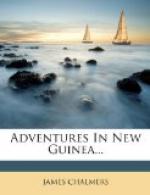The most important survey work along the coast of New Guinea was done in 1873 by H.M. ship Basilisk, under the command of Captain Moresby. He discovered the now-famous harbour, Port Moresby; he laid down the true eastern coastline of the island, discovering the China Straits, and exploring the north-east coast as far west as Huon Gulf.
In many parts of the world Christian missionaries have been the first to get on friendly terms with the natives, and thus to pave the way for developing the resources of a savage country and leading its inhabitants in the paths of progress and civilization. Pre-eminently has this been the case in South-eastern New Guinea. White men had landed before them, it is true; but for the most part only to benefit themselves, and not unfrequently to murder the natives or to entrap them into slavery. Christianity has won great victories in Polynesia, but no part of the globe has witnessed fouler crimes or more atrocious wickedness on the part of white men towards savage races.
The history of the work done by members of the London Missionary Society is already a long one. As far back as 1871, the Revs. A. W. Murray and S. McFarlane sailed from Mare, one of the Loyalty Islands, with eight native teachers, inhabitants of that group, with whom to begin the campaign against sin, superstition, and savagery in New Guinea. The first station occupied was Darnley Island, and Mr. Murray gives an incident that well illustrates the spirit in which these men, themselves trophies of missionary success, entered upon their work. Speaking about another island, the natives, in the hope of intimidating the teachers, said, “There are alligators there, and snakes, and centipedes.” “Hold,” said the teacher, “are there men there?” “Oh yes,” was the reply, “there are men; but they are such dreadful savages that it is no use your thinking of living among them.” “That will do,” replied the teacher. “Wherever there are men, missionaries are bound to go.” Teachers were stationed at the islands of Tauan and Sabaii. Later on, Yule Island and Redscar Bay were visited, and the missionaries returned to Lifu.
In 1872, Mr. Murray returned in the John Williams with thirteen additional teachers, and for the next two years superintended the mission from Cape York. In 1874, he was joined by the Revs. S. McFarlane and W. G. Lawes—who have both ever since that time laboured hard and successfully on behalf of the natives—and the steamer Ellengowan was placed at the service of the mission by the liberality of the late Miss Baxter, of Dundee. The native teachers experienced many vicissitudes. Some died from inability to stand the climate, some were massacred by the men they were striving to bless; but the gaps were filled up as speedily as possible, and the map recently issued (Jan. 1885) by the Directors of the Society shows that on the south-eastern coast of New Guinea, from Motumotu to East Cape, no less than thirty-two native teachers, some of them New Guinea converts, are now toiling in the service of the Gospel.




